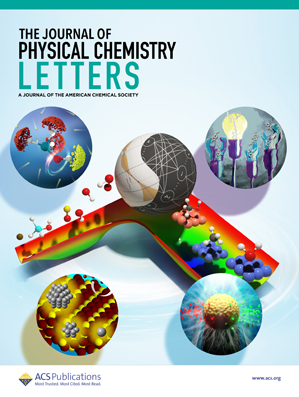跟踪有机激子-极化子的弛豫动力学和储层态。
IF 4.6
2区 化学
Q2 CHEMISTRY, PHYSICAL
引用次数: 0
摘要
有机激子极化子在光电子器件和光化学中引起了极大的关注,主要是因为它们具有微米级的扩散长度和可调的能级。最近的研究强调了储层状态在极化弛豫后的动力学过程中的关键作用。然而,关于水库状态的峰值分配及其在松弛期间的具体功能,仍然存在问题。在这项研究中,我们采用泵浦探针和二维电子能谱(2DES)结合模型模拟来研究有机激子-极化激子的光激发动力学。通过将实验数据与模拟数据进行比较,我们发现储层状态由不耦合于腔模式的暗态和激发态分子组成,每种状态都具有不同的光谱特征。对2DES的光谱演化分析表明,储层状态的产生有三种途径:直接光激发、中极化子的快速弛豫和低极化子的熵驱动弛豫。此外,我们发现在极化弛豫之后,无论激发波长如何,暗态和未耦合的激发态分子之间都建立了平衡。这种平衡有利于随后的极性离子再生。调节平衡常数可以通过设计光-物质相互作用强度来实现,为控制弛豫后极化动力学提供了一种策略。这些见解促进了我们对有机激子极化子弛豫动力学的理解,有助于下一代光电器件的设计。本文章由计算机程序翻译,如有差异,请以英文原文为准。
Tracking relaxation dynamics of polaritons and reservoir states in organic exciton-polaritons.
Organic exciton-polaritons have garnered significant attention in optoelectronic devices and photochemistry, primarily due to their micrometer-scale diffusion lengths and tunable energy levels. Recent studies have underscored the critical role of reservoir states in the dynamical processes following polaritonic relaxation. However, questions remain regarding the peak assignments of reservoir states and their specific functions during relaxation. In this study, we employed pump-probe and two-dimensional electronic spectroscopy (2DES) coupled with model simulations to investigate photoexcited dynamics of organic exciton-polaritons. By comparing experimental data with simulations, we identified that reservoir states consist of dark states and excited-state molecules uncoupled to the cavity mode, each exhibiting distinct spectral characteristics. Analyses of the spectral evolution in 2DES reveal that reservoir states are generated through three pathways: direct photoexcitation, rapid relaxation from middle polaritons, and entropy-driven relaxation from lower polaritons. Moreover, we find that equilibrium is established between dark states and uncoupled excited-state molecules following polaritonic relaxation, regardless of the excitation wavelength. This equilibrium facilitates subsequent polaritonic regeneration. Modulating the equilibrium constant can be achieved by engineering the light-matter interaction strength, offering a strategy to control postrelaxation polaritonic dynamics. These insights advance our understanding of relaxation dynamics in organic exciton-polaritons that can benefit the design of next-generation optoelectronic devices.
求助全文
通过发布文献求助,成功后即可免费获取论文全文。
去求助
来源期刊

The Journal of Physical Chemistry Letters
CHEMISTRY, PHYSICAL-NANOSCIENCE & NANOTECHNOLOGY
CiteScore
9.60
自引率
7.00%
发文量
1519
审稿时长
1.6 months
期刊介绍:
The Journal of Physical Chemistry (JPC) Letters is devoted to reporting new and original experimental and theoretical basic research of interest to physical chemists, biophysical chemists, chemical physicists, physicists, material scientists, and engineers. An important criterion for acceptance is that the paper reports a significant scientific advance and/or physical insight such that rapid publication is essential. Two issues of JPC Letters are published each month.
 求助内容:
求助内容: 应助结果提醒方式:
应助结果提醒方式:


